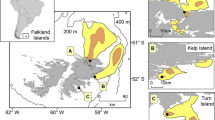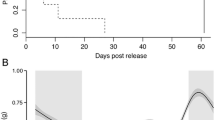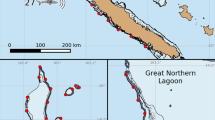Synopsis
We surgically implanted ultrasonic transmitters in 38 lemon sharks,Negaprion brevirostris, and manually tracked the sharks for 1–153 days. This yielded 2281 positional fixes recorded at 15-min intervals. We used these positional data with availability data of four environmental variables (water depth, temperature, salinity, and bottom type), sampled at 213 stations along 15 transects, to examine usage of habitat. All sharks used contours of water depth, water temperature, and bottom type disproportionately to the availability of these variables in the study site. Specifically, juvenile lemon sharks selected shallower, warmer water with an underlying rocky or sandy substrate, perhaps for predator avoidance. This is the first report on habitat selection by any elasmobranch.
Similar content being viewed by others
References cited
Bathurst, R.G.C. 1967. Oolitic films on low energy carbonate sand grains, Bimini Lagoon, Bahamas. Mar. Geol. 5: 89–109.
Bodurtha, T.S., J.M. Peek & J.L. Lauer. 1989. Mule deer habitat use related to succession in a bunchgrass community. J. Wildl. Manage. 53: 314–319.
Bushnell, P.G., P.L. Lutz & S.H. Gruber. 1989. The metabolic rate of an active, tropical elasmobranch, the lemon shark (Negaprion brevirostris). Exp. Biol. 48: 279–283.
Carey, F.G. & J.V. Scharold. 1990. Movements of blue sharks (Prionace glauca) in depth and course. Mar. Biol. 106: 329–342.
Chapman, C.A. & W.C. MacKay. 1984. Versatility in habitat use by a top aquatic predator,Esox lucius L. J. Fish Biol. 25: 109–115.
Compagno, L.J.V. 1984. FAO species catalogue. Vol. 4, parts 1 and 2: Sharks of the world. An annotated and illustrated catalogue of shark species known to date. FAO Fish. Synopsis 125: 1–655.
Cortes, E. & S.H. Gruber. 1990. Diet, feeding habits, and estimates of daily ration of young lemon sharks,Negaprion brevirostris (Poey). Copeia 1990: 204–218.
Coull, B.C. & J.B.J. Wells. 1983. Refuges from fish predation: experiments with phytal meiofauna from the New Zealand rocky intertidal. Ecology 64: 1599–1609.
Coutant, C.C. & D.S. Carroll. 1980. Temperatures occupied by ten ultrasonic-tagged striped bass in freshwater lakes. Trans. Amer. Fish. Soc. 109: 195–202.
Diana, J.S., W.C. Mackay & M. Ehrman. 1977. Movements and habitat preference of northern pike (Esox lucius) in Lac Ste. Anne, Alberta. Trans. Amer. Fish. Soc. 106: 560–565.
Fraser, D.F. & R.D. Cerri. 1982. Experimental evaluation of predator-prey relationships in a patchy environment: consequences for habitat use patterns in minnows. Ecology 63: 307–313.
Goodyear, C.P. 1973. Learned orientation in the predator avoidance behavior of mosquitofish,Gambusia affinis. Behav. 45: 191–224.
Gotceitas, V. & P. Colgan. 1990. The effects of prey availability and predator risk of habitat selection by juvenile bluegill sunfish. Copeia 1990: 409–417.
Gray, R.H. & J.M. Haynes. 1977. Depth distribution of adult chinook salmon (Oncorhynchus tshawytscha) in relation to season and gas-supersaturated water. Trans. Amer. Fish. Soc. 106: 617–620.
Greenbert, L.A. & D.A. Holtzman. 1987. Microhabitat utilization, feeding periodicity, home range and population size of the banded sculpin,Cottus carolinae. Copeia 1987: 19–25.
Gruber, S.H., D.R. Nelson & J.F. Morrissey. 1988. Patterns of activity and space utilization of lemon sharks,Negaprion brevirostris, in a shallow Bahamian lagoon. Bull. Mar. Sci. 43: 61–76.
Hammond, K.A., J.R. Spotilla & E.A. Standora. 1988. Basking behavior of the turtlePseudemys scripta: effects of digestive state, acclimation temperature, sex, and season. Physiol. Zool. 61: 69–77.
Harlin, M.N. 1980. Seagrass epiphytes. pp. 117–152.In: R.C. Phillips & C.P. McRoy(ed.) Handbook of Seagrass Biology, An Ecosystem Perspective, Garland STPM Press, New York
Harvey, J.T. 1989. Food habits, seasonal abundance, size, and sex of the blue shark,Prionace glauca, in Monterey Bay, California. Calif. Fish and Game 75: 33–44.
Heck, K.L. Jr. 1977. Comparative species richness, composition, and abundance of invertebrates in Caribbean seagrass (Thalassia testudinum) meadows (Panama). Mar. Biol. 42: 335–348.
Hershey, A.E. 1985. Effects of predatory sculpin on the chironomid communities in an arctic lake. Ecology 66: 1131–1138.
Hoese, H.D. & R.H. Moore. 1977. Fishes of the Gulf of Mexico. Texas A & M Univ. Press, College Station. 327 pp.
Holomuzki, J.R. 1986. Predator avoidance and diel patterns of microhabitat use by larval tiger salamanders. Ecology 67: 737–748.
Holomuzki, J.R. & T.M. Short. 1988. Habitat use and fish avoidance behaviors by the stream-dwelling isopodLirceus fontinalis. Oikos 52: 79–86.
Hutton, J. 1989. Movements, home range, dispersal and the separation of size classes in Nile crocodiles. Amer. Zool. 29: 1033–1049
Ireland, L.C. & J.W. Kanwisher. 1978. Underwater acoustic biotelemetry: procedures for obtaining information on the behavior and physiology of free-swimming aquatic animals in their natural environments. pp. 341–379.In: D.I. Mostofsky(ed.) The Behavior of Fish and Other Aquatic Animals, Academic Press, New York.
Itzkowitz, M. 1991. Habitat selection and subsequent reproductive success in the beaugregory damselfish. Env. Biol. Fish. 30: 287–293.
Jacobsen, T. 1987. An ecosystem-level study of a shallow, subtropical, marine lagoon, North Sound, Bimini, Bahamas. Ph.D. Thesis, University of Georgia, Athens. 186 pp.
Kaehler, S. & R.G. Hughes. 1992. The distributions and growth patterns of three epiphytic hydroids on the Caribbean seagrassThalassia testudinum. Bull. Mar. Sci. 51: 329–336.
Knight, T.W., J.A. Layfield & R.J. Brooks. 1990. Nutritional status and mean selected temperature of hatchling snapping turtles (Chelydra serpentina): is there a thermophilic response to feeding? Copeia 1990: 1067–1072.
Lang, J.W. 1981. Thermal preferences of hatchling New Guinea crocodiles: effects of feeding and ontogeny. J. Therm. Biol. 6: 73–78.
Lysenko, S. & J.E. Gillis. 1980. The effect of ingestive status on the thermoregulatory behavior ofThamnophis sirtalis sirtalis andThamnophis sirtalis parietalis. J. Herpetol. 14: 155–159.
Matthews, K.R. 1990. An experimental study of the habitat preferences and movement patterns of copper, quillback, and brown rockfishes (Sebastes spp.). Env. Biol. Fish. 29: 161–178.
McRoy, C.P. & C. Helfferich. 1977. Seagrass ecosystems. Marcel Dekker, Inc., New York. 314 pp.
Mech, D.L. 1983. Handbook of animal radio-tracking. University of Minnesota Press, Minneapolis. 107 pp.
Mesing, C.L. & A.M. Wicker. 1986. Home range, spawning migrations, and homing of radio-tagged Florida largemouth bass in two central Florida lakes. Trans. Amer. Fish. Soc. 115: 286–295.
Mittelbach, G. 1986. Predator-mediated habitat use: some consequences for species interactions. Env. Biol. Fish. 16: 159–169.
Morrissey, J.F. 1991. Activity space parameters, home range, diel activity rhythms, and habitat selection of juvenile lemon sharks,Negaprion brevirostris (Poey). Ph.D. Thesis, University of Miami, Miami. 141 pp.
Morrissey, J.E. & S.H. Gruber. 1993. Home range of juvenile lemon sharks,Negaprion brevirostris. Copeia 1993: 425–434.
Multer, H.G. 1969. Field guide to some carbonate rock environments. Kendall/Hunt Publishing Co., Dubuque. 391 pp.
Nelson, D.R. 1990. Telemetry studies of sharks: a review, with applications in resource management. pp. 239–256.In: H.L. Pratt Jr., S.H. Gruber & T Taniuchi (ed.) Elasmobranchs as Living Resources: Advances in the Biology, Ecology, Systematics, and the Status of the Fisheries, Proc. 2nd US-Japan workshop, NOAA Tech. Rep. NMFS 90.
Neu, C.W., C.R. Byers & J.M. Peek. 1974. A technique for analysis of utilization — availability data. J. Wildl. Manage. 38: 541–545.
Newell, N.D. & J. Imbrie. 1955. Biogeological reconnaissance in the Bimini area, Great Bahama Bank. Trans. NY Acad. Sci., Ser. II 18: 3–14.
Newell, N.D., J. Imbrie, E.G. Purdy & D.L. Thurber. 1959. Organism communities and bottom facies, Great Bahama Bank. Bull. Amer. Mus. Nat. Hist. 117: 181–228.
Novick, H.J. & G.R. Stewart. 1982. Home range and habitat preferences of black bears in the San Bernadino Mountains of southern California. Calif. Fish and Game 67: 21–35.
Power, M.E. 1984. Depth distributions of armored catfish: predator-induced resource avoidance? Ecology 65: 523–528.
Power, M.E. 1987. Predator avoidance by grazing fishes in temperate and tropical streams: importance of stream depth and prey size. pp. 333–351.In: W.C. Kerfoot & A. Sih(ed.) Predation: Direct and Indirect Impacts on Aquatic Communities. University Press of New England, Hanover.
Power, M.E., W.J. Matthews & A.J. Stewart. 1985. Grazing minnows, piscivorous bass, and stream algae: dynamics of a strong interaction. Ecology 66: 1448–1456.
Reeve, N.J. 1982. The home range of the hedgehog as revealed by a radio tracking study. Symp. Zool. Soc. Lord. 49: 207–230.
Richards, R.A. 1992. Habitat selection and predator avoidance: ontogenetic shifts in habitat use by the Jonah crabCancer borealis (Stimpson). J. Exp. Mar. Biol. Ecol. 156: 187–197.
Savino, J.F. & R.A. Stein. 1989. Behavior of fish predators and their prey: habitat choice between open water and dense vegetation. Env. Biol. Fish. 24: 287–293.
Schmidt, T.W. 1986. Food of young juvenile lemon sharks,Negaprion brevirostris (Poey), near Sandy Key, western Florida Bay Florida Sci. 49: 7–10.
Sih, A. 1980. Optimal behavior: can foragers balance two conflicting demands? Science 210: 1041–1043.
Stamps, J.A. 1983. The relationship between ontogenetic shifts, competition, and predator avoidance in a juvenile lizard (Anolis aeneus). Behav. Ecol. Sociobiol. 12: 19–33.
Strauss, R.E. 1979. Reliability for estimates for Ivlev's electivity index, the forage ratio, and a proposed linear index of food selection. Trans. Amer. Fish. Soc. 108: 344–352.
Stein, R.A. 1978. Behavioral response of prey to fish predators. pp. 343–353.In: R.H. Stroud & H. Clipper(ed.) Predator-Prey Systems in Fisheries Management. Sport Fishing Institute, Washington, D.C.
Supko, P.R., D. Marszalek & W. Bock. 1970. Sedimentary environments and carbonate rocks of Bimini, Bahamas. Miami Geological Society, Miami. 30 pp.
Thayer, G.W., D.R. Colby & W.F. Hettler Jr. 1987. Utilization of the red mangrove prop roots habitat by fishes in south Florida. Mar. Ecol. Prog. Ser. 35: 25–38.
Thomas, D.L. & E.J. Taylor. 1990. Study designs and tests for comparing resource use and availability. J. Wildl. Manage. 54: 322–330.
Todd, B.L. & C.F. Rabeni. 1989. Movement and habitat use by stream-dwelling smallmouth bass. Trans. Amer. Fish. Soc. 118: 229–242.
Turekian, K.H. 1957. Salinity variations in sea water in the vicinity of Bimini, Bahamas, British West Indies. Amer. Mus. Novit. 1822: 1–12.
van der Elst, R. 1979. A proliferation of small sharks in the shore-based Natal sport fishery. Env. Biol. Fish. 4: 349–362.
Vorenberg, M.M. 1962. Cannibalistic tendencies of lemon and bull sharks. Copeia 1962: 455–458.
Voss, G.L. & N.A. Voss. 1960. An ecological survey of the marine in vertebrates of Bimini, Bahamas, with a consideration of their zoogeographical relationships. Bull. Mar. Sci. 10: 96–116.
Walls, M., I. Kortelainen & J. Sarvala. 1990. Prey responses to fish predation in freshwater communities. Ann. Zool. Fennici 27: 183–199.
Werner, E.E., J.F. Gilliam, D.J. Hall & G.G. Mittelbach. 1983. An experimental test of the effects of predation risk on habitat use in fish. Ecology 64: 1540–1548.
Whitten, G.J. & H. Heatwole. 1978. Preferred temperature of the agamid lizardAmphiboluris nobbi nobbi. Copeia 1978: 362–364.
Winter, J.D. & M.J. Ross. 1981. Methods in analyzing fish habitat utilization. pp. 273–279.In: N.B. Armantrout(ed.) Acquisition and Utilization of Aquatic Habitat Inventory Information, Proc. of a Symposium, American Fisheries Society, Bethesda.
Wolcott, T.G. & A.H. Hines. 1990. Ultrasonic telemetry of small-scale movements and microhabitat selection by molting blue crabs (Callinectes sapidus). Bull. Mar. Sci. 46: 83–94.
Yano, K. & S. Tanaka. 1986. A telemetric study of the movements of the deep sea squaloid shark,Centrophorus acus. pp. 372–380.In: T. Uyeno, R. Arai, T. Taniuchi & K. Matsuura(ed.) Indo-Pacific Fish Biology: Proceedings of the Second International Conference on Indo-Pacific Fishes, Ichthyological Society of Japan, Tokyo.
Author information
Authors and Affiliations
Rights and permissions
About this article
Cite this article
Morrissey, J.F., Gruber, S.H. Habitat selection by juvenile lemon sharks,Negaprion brevirostris . Environ Biol Fish 38, 311–319 (1993). https://doi.org/10.1007/BF00007524
Received:
Accepted:
Issue Date:
DOI: https://doi.org/10.1007/BF00007524




